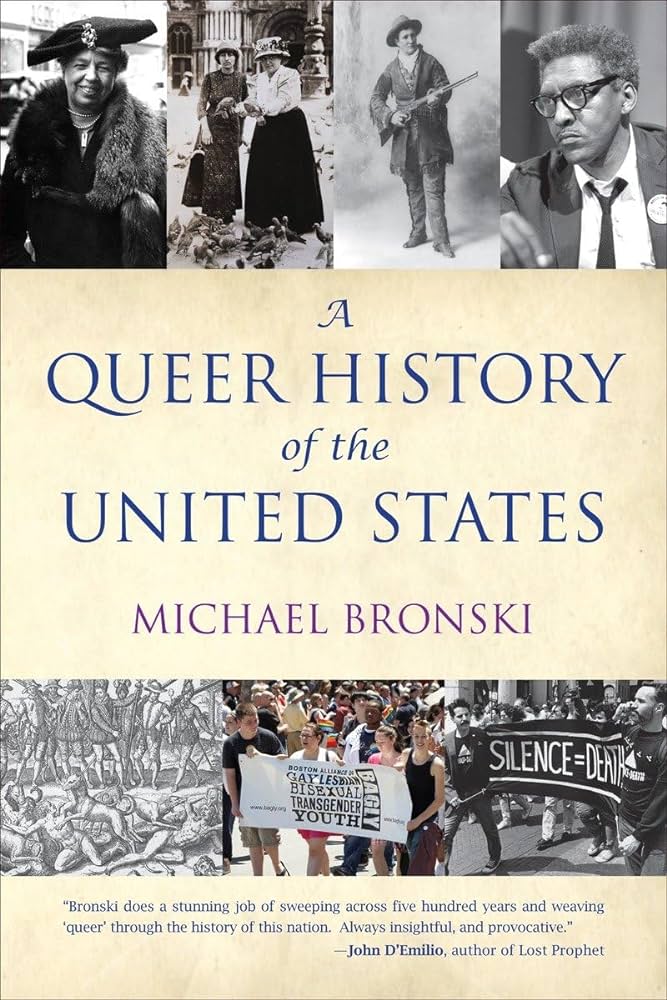A Queer History of the United States is a 2011 book by Michael Bronski who is a Professor of the Practice in Media and Activism in the Studies of Women, Gender, and Sexuality department at Harvard University. In 2012, this book won the American Library Association Israel Fishman Non-Fiction/Stonewall Book Award. It is recommended for readers 18 years of age and older due to its mature subject matter. In his text, Bronski provides a revealing look into LGBTQ+ history that begins with Columbus’s voyages in 1492 and into the 1980s with the AIDS Crisis. The author seeks to not only illuminate the ways LGBTQ+ culture has been formed by America but at the same time demonstrate the lasting impacts made by LGBTQ+ indviduals to the country as a whole. To that end, Bronski utilizes a combination of historical records, letters, books, and personal accounts to substantiate his claim. From the time the first settlers came to present day America, they brought with them strict notions regarding gender and sexuality that were used against minority groups, most notably Native Americans and the Black population. As America evolved, societal ideas along with gender roles expanded as well. These changes led to the creation of the Romantic Friendship in the 19th century and women secretly taking on combat roles during the Revolutionary and Civil Wars. However, this new awareness of sexual and gender diversity in the states and abroad were succeeded by efforts to stop the visibility of queer people with the Social Purity Movement at the Turn of the Century in addition to content restrictions placed upon theatre and film companies.
From the second World War on, queer people were starting to create a sense of community. This feeling of connection was attributed in part to burgeoning gay rights groups, the opening of gay bars, and nuanced depictions of LGBTQ+ characters in literature, namely the pulp novels of the ‘50s and ‘60s. It is this commonality as sexual and gender minorities that would lay the groundwork for the Gay Liberation Front, Gay Activist Alliance, and Lesbian Feminism during the ‘60s and ‘70s. In the 1980s, the fight for equality as well as recognition would take on even greater urgency as groups like ACT UP put pressure on the Reagan Administration and other government agencies to respond to the AIDS Epidemic.
Overall, Bronski does a phenomenal job of detailing how queer people have always existed in one way or another and that systems of oppression are, unfortunately, inextricably bound into the formation of the country. His historical account does, however, include lighthearted movements as he takes the opportunity to discuss gay fashion, how gay icon Bette Milder got her start performing in bathhouses, and the origins of camp. Bronski’s writing style is informative yet entertaining. This book is ideal for those who are looking for an introduction to LGBTQ+ history as this text is written with lay readers in mind. Bronski’s inclusion of the contributions made by two-spirit Native Americans along with transgender individuals is worth highlighting as these groups are not always talked about. It is critical in this current political climate that people take note of the patterns of discrimination that Bronski mentions in his book while thinking about the book bans and drag laws happening today.
Much like the unity achieved by early LGBTQ+ literature noted earlier, media can be used as a means to be involved in the community. If you are questioning your identity, would like to discuss coming out, or in need of local LGBTQ+ resources, please contact the National LGBT Help Center through the support services listed below.
Lesbian, Gay, Bisexual, and Transgender (LGBT) National Hotline: 1-888-843-4564
LGBT National Coming Out Support Hotline: 1-888-688-5428 (1-888-OUT-LGBT)
LGBT National Youth Talkline: 1-800-246-7743 (1-800-246-PRIDE)
LGBT National Senior Hotline: 1-888-234-7243
You can also reach out online at www.LGBThotline.org/chat

